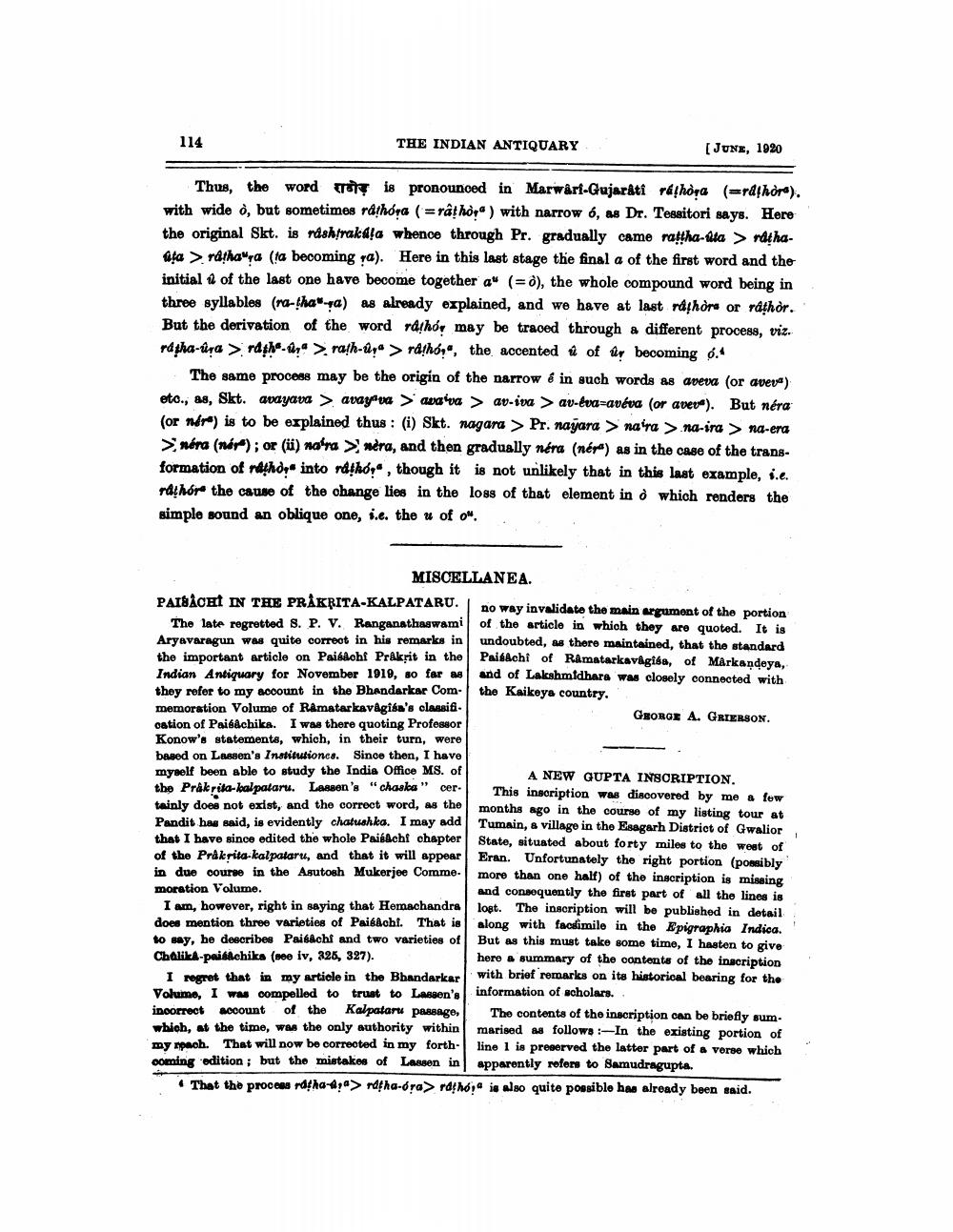________________
114
THE INDIAN ANTIQUARY
[JUNE, 1920
Thus, the word or is pronounced in Marwarf-Gujarati ráfhòra (=rdfhöre). with wide o, but sometimes rathóra ( = râthor" ) with narrow 6, as Dr. Tessitori says. Here the original Skt. is ndshtrakala whence through Pr. gradually came rattha-ilta > rdthaafa > rdthaya (ta becoming ra). Here in this last stage the final a of the first word and the initial of the last one have become together as (= 0), the whole compound word being in three syllables (na-tha"-a) as already explained, and we have at last ndihöra or rathor. But the derivation of the word rdthóy may be traced through a different process, viz. rapha-úra > ratha-10"> rath-" > råthor", the accented u of up becoming 6.4
The same process may be the origin of the narrow & in such words as aveva (or aveva) etc., as, Skt. avayava > avaytua > avatva > av-iva > av-Eva=avéva (or aveva). But néra (or nora) is to be explained thus : (i) Skt. nagara > Pr. nayara > na'ra > na-ira > na-era > nera (néra); or (ü) narra > nera, and then gradually néra (nér') as in the case of the transformation of naghoy into rathó;" , though it is not unlikely that in this last example, i.e. nathór the cause of the change lies in the loss of that element in d which renders the simple sound an oblique one, s.e. the u of o. .
D
MISCELLANEA. e t IN THE PRAKRITA-KALPATARU. no way invalidate the main argument of the portion The late regretted S. P. V. Ranganathaswami of the article in which they are quoted. It is Aryavaragun was quite correct in his remarks in undoubted, as there maintained, that the standard the important article on Paibachf Prakrit in the Paidacht of Ramatarkavagisa, of Markandeya, Indian Antiquary for November 1919, so far as and of Lakshmidhars was closely connected with they refer to my account in the Bhandarkar Com
the Kaikeys country. memoration Volume of Ramatar avâgisa's classifi.
GEORGE A. GRIERSON. oation of Paitachika. I was there quoting Professor Konow's statements, which, in their turn, were based on Lassen's Institutioncs. Since then, I have myself been able to study the India Office MS. of
A NEW GUPTA INSCRIPTION. the Prakrila-balpataru. Lassen 's "chaska" cer
This inscription was discovered by me a few tainly does not exist, and the correct word, as the months ago in the course of my listing tour at Pandit has said, is evidently chatushka. I may add Tumain, & village in the Esagarh District of Gwalior that I have since edited the whole Paibach chapter
State, situated about forty miles to the west of of the Prakrita kalpataru, and that it will appear Eran. Unfortunately the right portion (possibly in due course in the Agutosh Mukerjee Comme. more than one half) of the inscription is missing moration Volume.
and consequently the first part of all the lines is I am, however, right in saying that Hemachandra lost. The inscription will be published in detail does mention three varieties of Paibhohl. That is along with facilimile in the Epigraphia Indica. to say, be describee Paibach and two varieties of But as this must take some time, I hasten to give ChalikA-paifichika (nee iv, 226, 327).
hero a summary of the contents of the inscription I regret that in my article in the Bhandarkar with brief remarks on its historical bearing for the Volume, I was compelled to
ed to
trust to Lassen's
trust to Legen's information of scholars. incorrect account of the Kalpataru passage, The contents of the inscription can be briefly sumwbioh, at the time, was the only authority within marised as follows In the existing portion of my mach. That will now be corrected in my forth- line 1 is preserved the latter part of a verse which ooming edition ; but the mistakes of Lassen in apparently refers to Samudragupta.
That the process nafha-&?a> nafha-ora> rdthóra is also quite possible has already been said.




